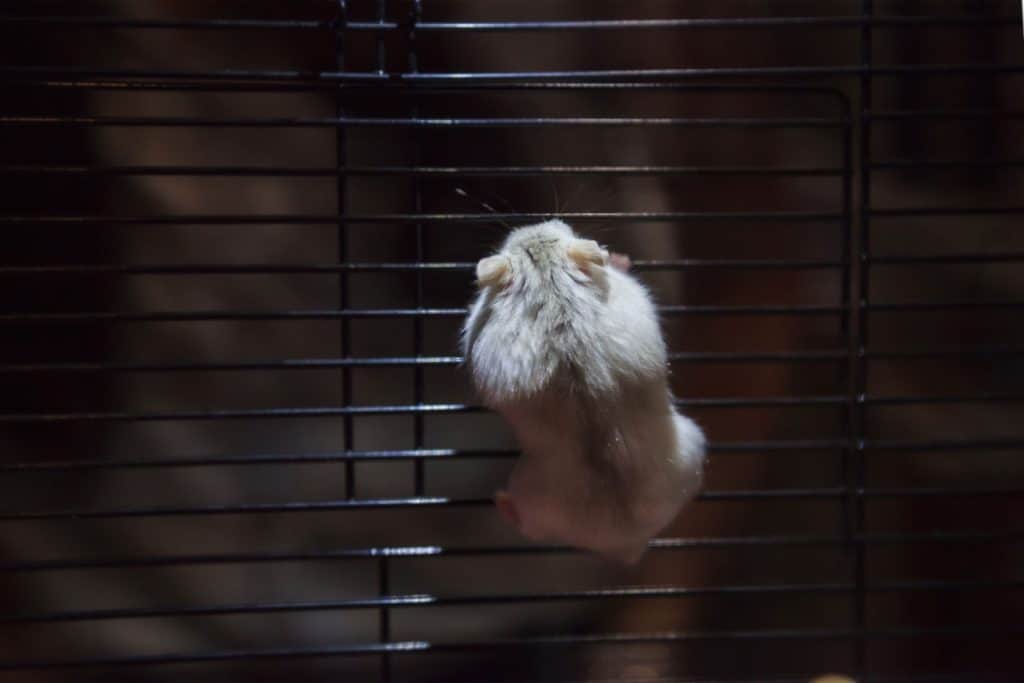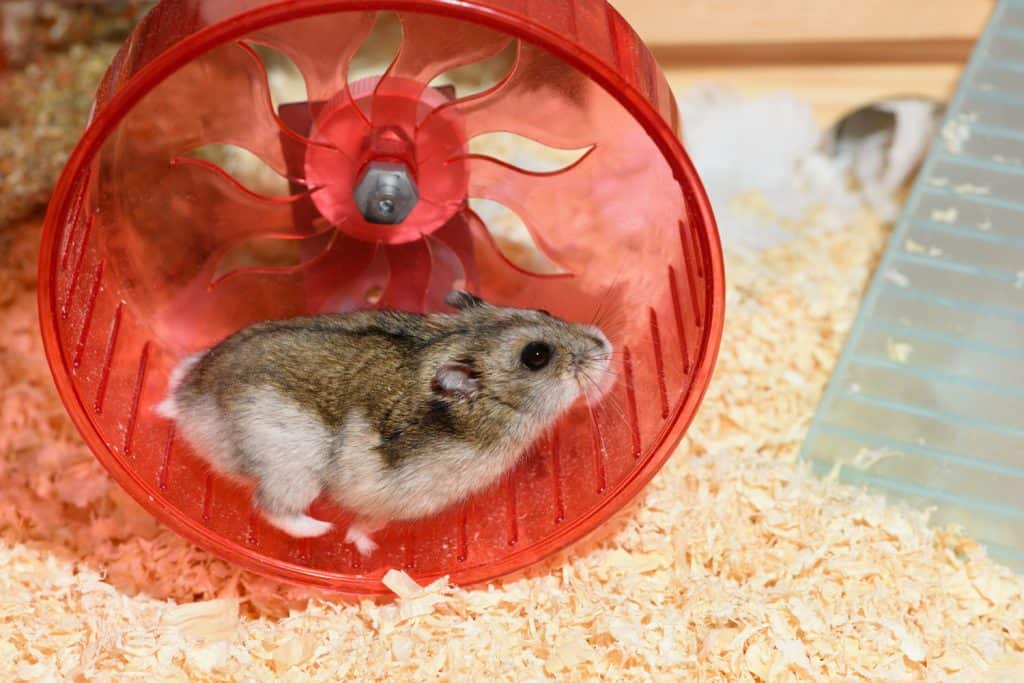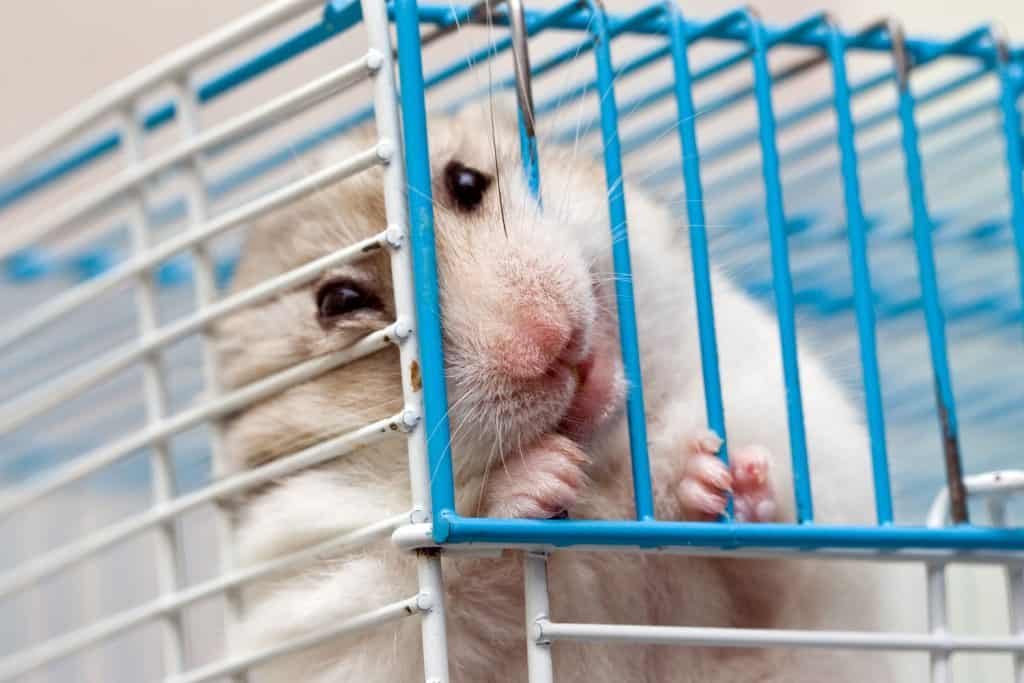At times, you may see your hamster climbing their cage and occasionally doing backflips. As a pet owner, you may be wondering if this is normal. This article will answer what it means when a hamster is climbing and more.
A hamster that is constantly climbing the bars of their cage may be experiencing one of the following:
- Inadequate environmental enrichment
- The need to burn energy
- They are trying to escape
In some cases, climbing can be an instinct. Other times, there could be an underlying issue to fix. Keep reading as we discuss the possibilities and answer how you can stop your hamster from climbing.

Why Is My Hamster Climbing The Walls And Ceiling Of Their Cage?
Part of the fun of having a hamster as a pet is getting to know their quirky behavior and personality. As you get to know each other, you will appreciate their habits and routines. Does part of your hamster's behavior include cage climbing?

The need to climb and explore is common for a hammie. However, this behavior done in excess or randomly starting can indicate your hamster is experiencing an issue.
In either case, you are probably wondering how to get this behavior to stop. The first step in preventing it is finding out why they are climbing in the first place.
Let's take a closer look at what could be going on.
Inadequate Environmental Enrichment
Environmental enrichment includes anything that provides your hamster with physical or emotional stimulation. Enrichment is necessary for your hamster's well-being.
The amount of enrichment needed can depend on your hamster's personality and demeanor. Meaning some hamsters require a bit more than others.

If your hamster is only cage climbing and not interacting with anything else in their cage, this behavior may come from a lack of environmental enrichment.
In these cases, you want to prevent your hamster from experiencing boredom. This can be done by adding new toys, props, levels, and treats to their home.
Additionally, you can provide them with more playtime or time out of their enclosure.
The Need To Burn Energy
Hamsters are tiny and full of energy. If your hamster randomly climbs their cage from time to time, but it is not a habit, they may be simply trying to burn the energy they have.
These small energy balls love to explore and work their muscles. There is nothing to worry about if no harm comes from the occasional climb.
However, giving your hamster plenty of opportunities to exercise outside the cage can reduce the need to climb the cage walls or ceiling for physical activity.
They Are Trying To Escape
Do you have a constantly climbing hamster, one that is charging the door or biting at the cage bars? This behavior can point to stress and the need to escape.

Hamsters, who are experiencing fear or not liking something in their environment, will try to run away from it. Inspect their enclosure for anything bothersome, as well as the environment around their home.
Your hamster's enclosure should be their safe haven. This is a place they go to hide, eat, sleep and relax. It is important to keep your hamster's home in a condition where they feel safe and comfortable to do these things.
Is It Bad To Let My Hamster Climb Their Cage?
There are some downfalls to allowing your hamster to climb their cage. If they are climbing their cage because they lack something in other parts of their life or are stressed, then it is necessary to resolve the root issue.
Even hamsters who climb occasionally are subject to certain risks. If you have a particularly high cage, your climbing hamster can fall and experience a broken bone or other injuries.
Climbing is hazardous if your hamster has any pre-existing conditions, like tumors or old injuries. In most cases, climbing is a behavior that should be discouraged and stopped.
How Do I Stop My Hamster From Climbing The Cage?
The simplest way to get your hamster to stop climbing their cage is to ensure they have plenty of other things to do. Keeping your hamster healthy and thoroughly entertained can stop most undesired behaviors.
You can create layers within your hammie's enclosure by adding additional floors or tubing. Having items they can climb on or through will help motivate them to stop climbing the cage bars.
Other forms of entertainment include hamster wheels or balls, ladders, puzzle toys, and more.
See this puzzle toy for hamsters here on Amazon.
Getting your hamster out of their cage more may help them burn energy. Playing games with them and allowing them to explore should burn enough energy, so they won't need to climb their cage.
For the hamsters that are climbing to escape, you have to locate and eliminate the source of stress. Stress can come from soiled bedding, spoiling food, specific toys, noise in or around the cage, other pets, and more.
Read more on our blog post, "How To Stop My Hamster From Chewing The Bars Of The Cage?"
How Do You Tell If Your Hamster Is Stressed?
Knowing the signs of stress in a hamster will help you know when your pet has an issue. Eliminating stress from your hamster's environment is vital to keeping them healthy and happy.
Signs or symptoms your hamster is experiencing stress include the following:
- Lack of appetite or intake of water
- Excessive hiding
- Attempting to escape
- Aggressive behavior
- Teeth chattering
- Hair loss
- Repetitive behavior, like pacing
- Lethargy
- Acting skittish
- Freezing up
Any change in your hamster's normal routine can point to feeling stress. If you notice any of the above behaviors, the next step is finding and reducing stress for your pet.
You can lower stress for your hamster by maintaining a consistent schedule, keeping their enclosure clean and quiet, eliminating immediate sounds or movement around their home, and providing plenty of toys and treats.
Learn more on our blog post, "My Hamster Is Scared Of Me - What To Do?"
What Is Hamster Cage Rage?
Hamster cage rage is a physiological disorder that can develop from a hamster being in too small of an enclosure. This disorder results in your hamster experiencing deranged and dangerous behaviors.
Signs of cage range look like aggressive or anxious behaviors. These signs include the following:
- Excessive bar biting
- Destroying toys or other items in their home
- Increased aggression both in and out of the cage
- Frenzied attacks when being handled
- Abnormal squealing or spitting
- Possessive behavior over their cage
- Food hoarding
- Change in sleep patterns

Some of these symptoms can look like just stress or anxiety, making cage rage harder to identify.
However, hamsters are not aggressive by nature. Showing one or more of these symptoms makes it likely your hamster is experiencing cage rage.
Cage rage is one of the most common issues your hamster may experience, but it is also one of the most preventable. Ensure your hamster has a large enough cage. Typically the bigger, the better.
Learn more on our blog post, "What Size Cage Does A Hamster Need?"
How Do I Know If My Hamster Is Happy?
Your hamster shows plenty of signs when they are unhappy or stressed, but how can you tell that your pet is happy?
Hamsters express themselves in subtle ways. Knowing their usual routines and behavior can help you determine their mood. Some subtle signs that your hamster is happy include yawning, stretching, and grooming routines.

Additionally, happy hamsters are playful and interactive. They will wait for you at their cage door to be handled or played with. Curious hamsters that are frequently playing with their toys is another good sign.
Simple things like a good appetite and motivation to exercise are more signs that your hamster is comfortable and happy.
Getting your hamster to their ideal happy place starts with knowing what your hamster likes and dislikes. If you are a new pet owner, this process can take a little trial and error until you find what suits them and you.
Read more on our blog post, "25 Ways To Make Your Hamster Happy".
In Summary
Your hamster may be climbing due to stress, lack of enrichment, or simply the need to get some energy expelled. We hope you found this article helpful when dealing with a climbing hamster.
Are you looking for more insights into hamster behavior? Have a look through our blog post, "My Hamster Always Wants Attention - Is This Okay?"




